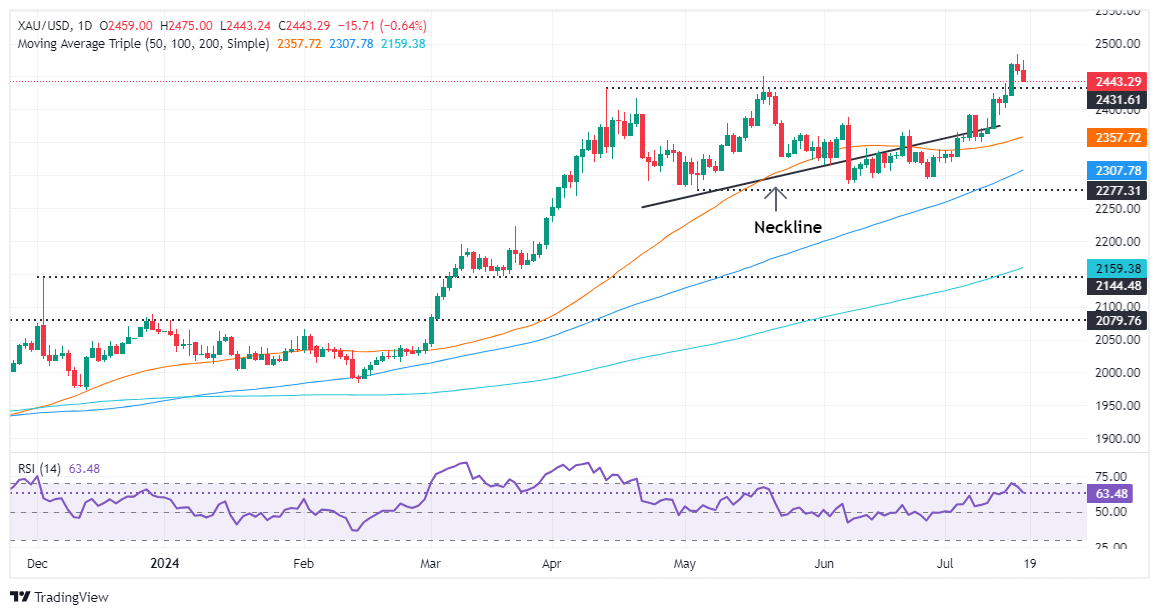Gold price slips beneath $2,450 despite growing Fed rate cut speculation
- Gold is down more than 0.50% amid anticipation of a September Fed rate cut.
- US jobless claims exceed forecasts, suggesting economic slowdown and favoring lower rates.
- US Dollar Index up 0.43% to 104.18; 10-year Treasury yields increase by 2.5 basis points to 4.187%.
Gold prices continued to drop on Thursday, though remaining at around familiar levels of $2,450 per troy ounce, as speculation that the Federal Reserve would lower borrowing costs at the September meeting grew. At the time of writing, the XAU/USD trades at $2,443 with losses of 0.20% as the Greenback stages a recovery, underpinned by elevated US Treasury yields.
US jobs data revealed by the US Bureau of Labor Statistics (BLS) showed that more people than expected are applying for unemployment benefits, indicating an economic slowdown. This, added to last week’s string of data showing that inflation is aiming towards the Fed’s 2% goal, is beginning to gather policymakers' attention.
The number of Americans filing new applications for unemployment benefits rose more than expected last week, but there has been no material shift in the labor market, according to data released by the Labor Department on Thursday.
Lastly, Federal Reserve officials had expressed that the central bank could be “closer” to lower borrowing costs as the dual mandate risks had become more balanced. However, the International Monetary Fund (IMF) said on Thursday that the Fed should not cut interest rates until late 2024.
Given the backdrop, Gold prices recorded an all-time high of $2,483, but buyers failed to cling to gains as investors booked profits. This, along with former US President Donald Trump’s rhetoric of imposing at least 60% tariffs on China’s products, spurred flows to the American dollar.
The US Dollar Index, which tracks the currency's performance against six other currencies, is up 0.43% at 104.18. US Treasury bond yields are also rising across the yield curve, with the 10-year Treasury note yielding 4.187%, up more than two and a half basis points (bps).
Daily digest market movers: Gold retreats as buyers take a breather close to $2,500
- Weaker-than-expected US Consumer Price Index (CPI) data boosted gold prices above $2,400, as the increased likelihood of Fed rate cuts led to falling US Treasury bond yields.
- US Initial Jobless Claims, as reported by the BLS, showed that the number of Americans filing for unemployment benefits in the week ending July 13 rose to 243K, above the estimated 230K, exceeding the previous week's reading of 223K.
- December 2024 fed funds rate futures contract implies that the Fed will ease policy by 52 basis points (bps) toward the end of the year, up from 50 last Friday.
Gold technical analysis: XAU/USD tumbles beneath $2,460 as buyers take a breather
The Gold price is experiencing a pullback, hinting that traders are booking profits after rallying more than 8% during the last three weeks. Momentum remains bullish in the mid-term, but the Relative Strength Index (RSI) aims lower, which indicates that buyers are taking a respite before lifting the precious metal to higher prices.
In the short term, the XAU/USD is headed to the downside, and if it achieves a daily close below $2,450, that will pave the way to challenge $2,400. Further losses lie beneath, and XAU/USD could dive to the July 5 high at $2,392, followed by the psychological $2,350 mark.
Otherwise, if XAU/USD conquers $2,490, that can pave the way to print a new all-time high of $2,500.

Gold FAQs
Gold has played a key role in human’s history as it has been widely used as a store of value and medium of exchange. Currently, apart from its shine and usage for jewelry, the precious metal is widely seen as a safe-haven asset, meaning that it is considered a good investment during turbulent times. Gold is also widely seen as a hedge against inflation and against depreciating currencies as it doesn’t rely on any specific issuer or government.
Central banks are the biggest Gold holders. In their aim to support their currencies in turbulent times, central banks tend to diversify their reserves and buy Gold to improve the perceived strength of the economy and the currency. High Gold reserves can be a source of trust for a country’s solvency. Central banks added 1,136 tonnes of Gold worth around $70 billion to their reserves in 2022, according to data from the World Gold Council. This is the highest yearly purchase since records began. Central banks from emerging economies such as China, India and Turkey are quickly increasing their Gold reserves.
Gold has an inverse correlation with the US Dollar and US Treasuries, which are both major reserve and safe-haven assets. When the Dollar depreciates, Gold tends to rise, enabling investors and central banks to diversify their assets in turbulent times. Gold is also inversely correlated with risk assets. A rally in the stock market tends to weaken Gold price, while sell-offs in riskier markets tend to favor the precious metal.
The price can move due to a wide range of factors. Geopolitical instability or fears of a deep recession can quickly make Gold price escalate due to its safe-haven status. As a yield-less asset, Gold tends to rise with lower interest rates, while higher cost of money usually weighs down on the yellow metal. Still, most moves depend on how the US Dollar (USD) behaves as the asset is priced in dollars (XAU/USD). A strong Dollar tends to keep the price of Gold controlled, whereas a weaker Dollar is likely to push Gold prices up.
